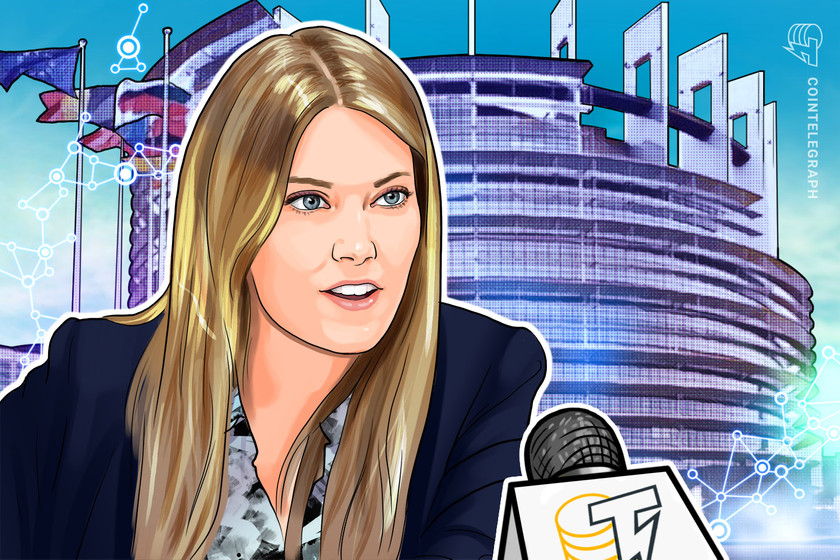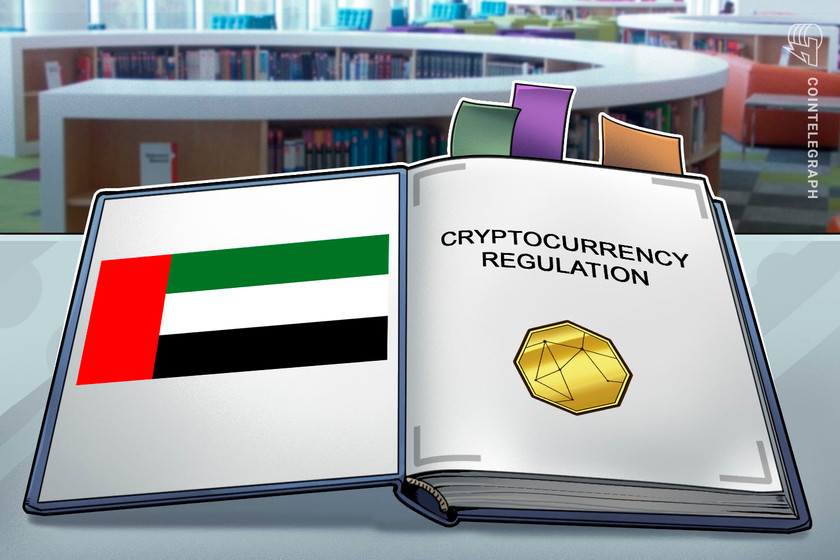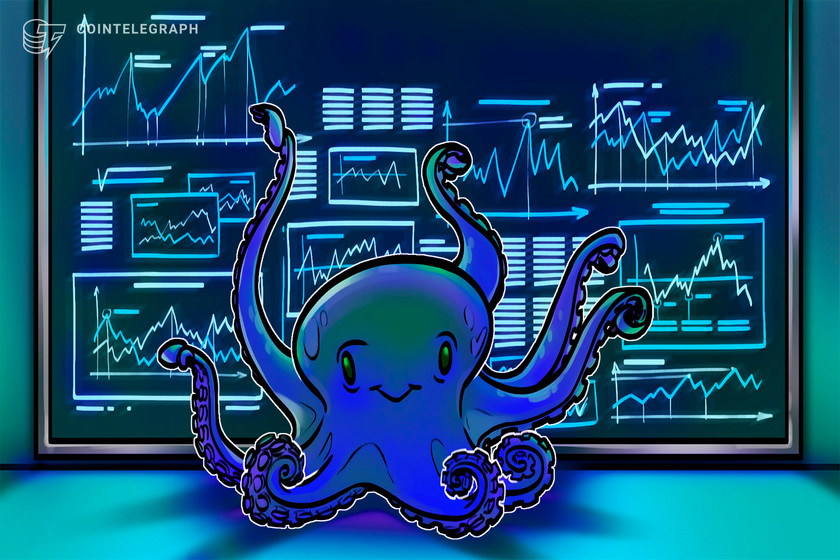What is quantitative easing, and how does it work?
What is Bitcoin? How does blockchain work? How to mine cryptocurrency? We are glad to help you answer these questions with our quick guides in Explained section.
rn”,”seo_description”:”What is Bitcoin? How does blockchain work? How to mine cryptocurrency? We are glad to help you answer these questions with our quick guides in Explained section.”,”enabled”:1},”words_count”:945,”description”:”Quantitative easing is a monetary policy tool where a central bank purchases financial assets to increase the money supply and stimulate economic activity.”,”author”:{“id”:1470,”title”:”Onkar Singh”,”url”:”onkar-singh”,”twitter”:””,”google_plus”:””,”photo”:””,”gender”:”male”,”description”:”Onkar Singh is a blockchain enthusiast as he keeps a tab on the recent happenings pertaining to the crypto industry. He aims to provide quality content in blockchain and crypto domain. He is a financial content writer too and has worked on several financial projects related to the stock market news, fundamental research, and technical analysis for several websites.”,”facebook”:””,”email”:””,”linkedin”:””,”created_at”:”2022-01-28 14:30:55″,”updated_at”:”2022-04-05 22:44:33″,”deleted_at”:null,”innovation_circle_url”:null,”avatar”:”https://cointelegraph.com/assets/img/icons/author_male.jpg”,”hash”:”aHR0cHM6Ly9jb2ludGVsZWdyYXBoLmNvbS9hdXRob3JzL29ua2FyLXNpbmdo”,”relativeUrl”:”https://cointelegraph.com/authors/onkar-singh”,”user_id”:1470,”language_id”:1,”name”:”Onkar Singh”,”desc”:”Onkar Singh is a blockchain enthusiast as he keeps a tab on the recent happenings pertaining to the crypto industry. He aims to provide quality content in blockchain and crypto domain. He is a financial content writer too and has worked on several financial projects related to the stock market news, fundamental research, and technical analysis for several websites.”,”seo_title”:””,”seo_description”:””,”enabled”:1,”show_in_authors”:0,”show_in_experts”:0},”category_id”:65,”audio”:””,”tags”:[{“name”:”Cryptocurrencies”,”uri”:”/tags/cryptocurrencies”,”super”:0,”page_title”:”Cryptocurrencies News”},{“name”:”Business”,”uri”:”/tags/business”,”super”:1,”page_title”:”Business News”},{“name”:”Banks”,”uri”:”/tags/banks”,”super”:0,”page_title”:”Banks News”},{“name”:”Central Bank”,”uri”:”/tags/central-bank”,”super”:0,”page_title”:”Central Bank News”},{“name”:”Economics”,”uri”:”/tags/economics”,”super”:0,”page_title”:”Economics News”}],”tag_title”:”Business”,”date”:”34 MINUTES AGO”,”badge”:{“title”:”Explained”,”label”:”default”},”qty”:3,”stats_pixel”:”“,”stats_pixel_url”:”https://zoa.cointelegraph.com/pixel?postId=116163®ionId=1″,”shares”:3,”infographic”:false,”sponsored”:false,”explained”:true,”press_release”:false,”show_referral”:false,”social_description”:”Quantitative easing is when central banks buy financial assets to pump more money into the economy. It’s aimed at boosting growth when other tools, such as adjusting interest rates, aren’t cutting it. Here are the details.”,”social_translators”:{“clipboard_popup_label”:”Link copied”,”socialWechatFooterError”:”WeChat error”,”socialWechatFooterText”:”WeChat share”,”socialWechatHeaderText”:”WeChat share”},”social_shares”:{“post_id”:116163,”post_url”:”https://cointelegraph.com/explained/what-is-quantitative-easing-and-how-does-it-work”,”post_titles”:{“normal”:”What is quantitative easing, and how does it work?”,”twitter”:”What is quantitative easing, and how does it work?”},”post_text”:{“normal”:”What is quantitative easing, and how does it work?”,”twitter”:”What is quantitative easing, and how does it work? https://cointelegraph.com/explained/what-is-quantitative-easing-and-how-does-it-work via @cointelegraph”},”accounts”:{“twitter”:”@cointelegraph”}},”socials”:{“facebook”:{“url”:”https://www.facebook.com/sharer/sharer.php?u=https%3A%2F%2Fcointelegraph.com%2Fexplained%2Fwhat-is-quantitative-easing-and-how-does-it-work”,”count”:null,”short”:”fb”,”fa”:”facebook”},”twitter”:{“url”:”https://twitter.com/intent/tweet?text=What+is+quantitative+easing%2C+and+how+does+it+work%3F https%3A%2F%2Fcointelegraph.com%2Fexplained%2Fwhat-is-quantitative-easing-and-how-does-it-work via @cointelegraph”,”count”:null,”short”:”tw”,”fa”:”twitter”},”telegram”:{“url”:”https://telegram.me/share/url?url=https%3A%2F%2Fcointelegraph.com%2Fexplained%2Fwhat-is-quantitative-easing-and-how-does-it-work &text=What+is+quantitative+easing%2C+and+how+does+it+work%3F”,”count”:null,”short”:”tg”,”fa”:”paper-plane”},”whatsapp”:{“url”:”https://api.whatsapp.com/send?text=What+is+quantitative+easing%2C+and+how+does+it+work%3F&href=https%3A%2F%2Fcointelegraph.com%2Fexplained%2Fwhat-is-quantitative-easing-and-how-does-it-work”,”count”:null,”short”:”wu”,”fa”:”whatsapp”},”gplus”:{“url”:”https://plus.google.com/share?url=https%3A%2F%2Fcointelegraph.com%2Fexplained%2Fwhat-is-quantitative-easing-and-how-does-it-work”,”count”:null,”short”:”gplus”,”fa”:”google-plus”},”reddit”:{“url”:”https://www.reddit.com/submit?url=https%3A%2F%2Fcointelegraph.com%2Fexplained%2Fwhat-is-quantitative-easing-and-how-does-it-work&title=What+is+quantitative+easing%2C+and+how+does+it+work%3F”,”count”:null,”short”:”reddit”,”fa”:”reddit-alien”},”linkedin”:{“url”:”https://www.linkedin.com/shareArticle?mini=true&url=https%3A%2F%2Fcointelegraph.com%2Fexplained%2Fwhat-is-quantitative-easing-and-how-does-it-work&title=What+is+quantitative+easing%2C+and+how+does+it+work%3F”,”count”:null,”short”:”li”,”fa”:”linkedin”}},”hide_disclaimer”:false,”elink”:”https://cointelegraph.com”,”etitle”:”Cointelegraph”,”elogo_x2″:”https://images.cointelegraph.com/cdn-cgi/image/format=auto,onerror=redirect,quality=90,width=528/https://s3.cointelegraph.com/storage/uploads/view/ab03a2a2ce9a21dc1f0961d91731c8ba.png”,”elogo_x1″:”https://images.cointelegraph.com/cdn-cgi/image/format=auto,onerror=redirect,quality=90,width=260/https://s3.cointelegraph.com/storage/uploads/view/ab03a2a2ce9a21dc1f0961d91731c8ba.png”,”elogo_svg”:false,”content”:[{“id”:4321,”post_id”:116163,”title”:”Understanding quantitative easing “,”content”:”
Quantitative easing entails the central bank acquiring financial assets off the market, such as government bonds.
nn
When interest rates are low and conventional measures are less successful, central banks use the monetary policy tool known as quantitative easing (QE) to boost the economy. The central bank initiates QE by acquiring financial assets from business banks, financial institutions and, occasionally, the open market. Government bonds are the most commonly bought assets, but central banks can also purchase corporate bonds or mortgage-backed securities.
nn
The central bank issues new currency to cover the cost of these purchases. As a result, the economy has more money available. The freshly produced money is given to the asset sellers, which are often banks, in exchange for the assets they sell to the central bank.
nn
The central bank raises demand for assets by purchasing significant amounts of them, particularly government bonds. As a result, these assets become more expensive, and, in turn, their yields or interest rates decline. Lower long-term interest rates stimulate spending and borrowing, as well as stock and real estate investments in riskier assets.
nn
The United States Federal Reserve implemented quantitative easing to amplify the money supply and invigorate economic expansion, addressing the repercussions of the COVID-19 pandemic’s impact. As a result, the Federal Reserve’s balance sheet surged to approximately $8.24 trillion (as purchased assets were added to the central bank’s balance sheet).
nn
One of the key concerns with QE is its potential impact on inflation. A considerable infusion of cash into the economy could result in price increases if the growth of products and services is outpaced by the expansion of the money supply. However, this risk depends on a number of variables, including the overall health of the economy, consumer and business trends, and the central bank’s capacity to successfully control the money supply.
nnnn”,”created_at”:”2023-09-08 09:12:08″,”updated_at”:”2023-09-08 09:12:08″,”sort”:1,”translations”:{“id”:4314,”explained_post_id”:4321,”title_en”:”Understanding quantitative easing “,”content_en”:”
Quantitative easing entails the central bank acquiring financial assets off the market, such as government bonds.
nn
When interest rates are low and conventional measures are less successful, central banks use the monetary policy tool known as quantitative easing (QE) to boost the economy. The central bank initiates QE by acquiring financial assets from business banks, financial institutions and, occasionally, the open market. Government bonds are the most commonly bought assets, but central banks can also purchase corporate bonds or mortgage-backed securities.
nn
The central bank issues new currency to cover the cost of these purchases. As a result, the economy has more money available. The freshly produced money is given to the asset sellers, which are often banks, in exchange for the assets they sell to the central bank.
nn
The central bank raises demand for assets by purchasing significant amounts of them, particularly government bonds. As a result, these assets become more expensive, and, in turn, their yields or interest rates decline. Lower long-term interest rates stimulate spending and borrowing, as well as stock and real estate investments in riskier assets.
nn
The United States Federal Reserve implemented quantitative easing to amplify the money supply and invigorate economic expansion, addressing the repercussions of the COVID-19 pandemic’s impact. As a result, the Federal Reserve’s balance sheet surged to approximately $8.24 trillion (as purchased assets were added to the central bank’s balance sheet).
nn
One of the key concerns with QE is its potential impact on inflation. A considerable infusion of cash into the economy could result in price increases if the growth of products and services is outpaced by the expansion of the money supply. However, this risk depends on a number of variables, including the overall health of the economy, consumer and business trends, and the central bank’s capacity to successfully control the money supply.
nnnn”,”title_es”:””,”content_es”:”nn”,”title_cn”:””,”content_cn”:”nn”,”title_de”:””,”content_de”:”nn”,”title_fr”:””,”content_fr”:”nn”,”title_it”:””,”content_it”:”nn”,”title_ar”:””,”content_ar”:”nn”,”title_br”:””,”content_br”:”nn”,”title_jp”:””,”content_jp”:”nn”,”created_at”:”2023-09-08 09:12:08″,”updated_at”:”2023-09-08 09:38:16″,”title_kr”:””,”content_kr”:”nn”,”title_tr”:””,”content_tr”:”nn”}},{“id”:4322,”post_id”:116163,”title”:”How does quantitative easing extend to the realm of cryptocurrencies?”,”content”:”
Although there are parallels between some measures taken in the world of cryptocurrencies and the consequences of quantitative easing, it is difficult to directly apply conventional ideas of monetary policy to cryptocurrencies due to their decentralized nature.
nn
In contrast to traditional financial systems, the idea of QE does not apply directly to the world of cryptocurrencies. Cryptocurrencies, such as Bitcoin (BTC) and Ether (ETH), run on decentralized networks and are not regulated by governments or central banks. As a result, no one institution can implement conventional monetary policy measures like quantitative easing in the crypto industry.
nn
However, there are some potential implications to consider:
nn
Supply dynamics
nn
Traditional quantitative easing involves central banks buying financial assets to raise the money supply. In the world of cryptocurrencies, some cryptocurrencies, such as BTC, which has a fixed supply of 21 million coins, have set or capped supplies. Thus, there are differences in supply dynamics. These coins don’t produce new units; therefore, hodlers may see swings in value owing to supply constraints.
nn
Forking and airdrops
nn
In the cryptocurrency world, there are situations where new tokens are handed to existing hodlers, similar to a central bank’s quantitative easing program in that it expands the quantity of tokens. QE-like distributional effects can be produced through forks and airdrops, but they frequently arise from technical developments or community decisions rather than from deliberate monetary policy.
nn
Stablecoins and collateral
nn
Some stablecoins could theoretically be used in ways similar to QE. For instance, if a stablecoin issuer were to create more stablecoins backed by additional collateral, it could resemble an expansion of the money supply. Stablecoins are often tied to real-world assets; thus, this isn’t precisely the same as QE.
nn
Market dynamics
nn
Due to a variety of reasons, including market sentiment, technological breakthroughs, regulatory developments and macroeconomic trends, cryptocurrency markets may see price gains or reductions. Sometimes, these price changes might be compared to how monetary policy affects conventional assets.
nnnn”,”created_at”:”2023-09-08 09:12:28″,”updated_at”:”2023-09-08 09:12:28″,”sort”:2,”translations”:{“id”:4315,”explained_post_id”:4322,”title_en”:”How does quantitative easing extend to the realm of cryptocurrencies?”,”content_en”:”
Although there are parallels between some measures taken in the world of cryptocurrencies and the consequences of quantitative easing, it is difficult to directly apply conventional ideas of monetary policy to cryptocurrencies due to their decentralized nature.
nn
In contrast to traditional financial systems, the idea of QE does not apply directly to the world of cryptocurrencies. Cryptocurrencies, such as Bitcoin (BTC) and Ether (ETH), run on decentralized networks and are not regulated by governments or central banks. As a result, no one institution can implement conventional monetary policy measures like quantitative easing in the crypto industry.
nn
However, there are some potential implications to consider:
nn
Supply dynamics
nn
Traditional quantitative easing involves central banks buying financial assets to raise the money supply. In the world of cryptocurrencies, some cryptocurrencies, such as BTC, which has a fixed supply of 21 million coins, have set or capped supplies. Thus, there are differences in supply dynamics. These coins don’t produce new units; therefore, hodlers may see swings in value owing to supply constraints.
nn
Forking and airdrops
nn
In the cryptocurrency world, there are situations where new tokens are handed to existing hodlers, similar to a central bank’s quantitative easing program in that it expands the quantity of tokens. QE-like distributional effects can be produced through forks and airdrops, but they frequently arise from technical developments or community decisions rather than from deliberate monetary policy.
nn
Stablecoins and collateral
nn
Some stablecoins could theoretically be used in ways similar to QE. For instance, if a stablecoin issuer were to create more stablecoins backed by additional collateral, it could resemble an expansion of the money supply. Stablecoins are often tied to real-world assets; thus, this isn’t precisely the same as QE.
nn
Market dynamics
nn
Due to a variety of reasons, including market sentiment, technological breakthroughs, regulatory developments and macroeconomic trends, cryptocurrency markets may see price gains or reductions. Sometimes, these price changes might be compared to how monetary policy affects conventional assets.
nnnn”,”title_es”:””,”content_es”:”nn”,”title_cn”:””,”content_cn”:”nn”,”title_de”:””,”content_de”:”nn”,”title_fr”:””,”content_fr”:”nn”,”title_it”:””,”content_it”:”nn”,”title_ar”:””,”content_ar”:”nn”,”title_br”:””,”content_br”:”nn”,”title_jp”:””,”content_jp”:”nn”,”created_at”:”2023-09-08 09:12:28″,”updated_at”:”2023-09-08 09:38:16″,”title_kr”:””,”content_kr”:”nn”,”title_tr”:””,”content_tr”:”nn”}},{“id”:4323,”post_id”:116163,”title”:”How does quantitative easing work?”,”content”:”
QE is a central bank’s strategy of injecting money into its economy by buying assets to lower interest rates and boost economic activity.
nn
The authority to engage in QE as part of its monetary policy tools is granted to central banks like the Federal Reserve in the U.S., the European Central Bank or the Bank of Japan. These central banks make strategic efforts to boost the economy when more conventional policies, such as interest rate adjustments, are less successful.
nn
There are various steps involved in this process. First, the central bank determines the economic circumstances that call for QE, which frequently occur during recessions or times of low inflation. Once a decision has been made, the central bank declares its intention to purchase financial assets, such as equities or bonds, from the market.
nn
By doing this, the bank raises interest rates and stimulates demand for these assets, which in turn drives up their prices. The central bank generates new money digitally to enable these purchases, which it then uses to pay the sellers, often banks or financial institutions. As a result, the economy’s money supply grows. The increased availability of funds may boost borrowing, investing and spending.
nn
QE aims to stimulate economies by boosting the money supply and lowering long-term interest rates. When conventional monetary policies are insufficient, they promote lending, investment and expenditure to enhance growth while reducing deflationary pressures.
nnnn”,”created_at”:”2023-09-08 09:12:46″,”updated_at”:”2023-09-08 09:12:46″,”sort”:3,”translations”:{“id”:4316,”explained_post_id”:4323,”title_en”:”How does quantitative easing work?”,”content_en”:”
QE is a central bank’s strategy of injecting money into its economy by buying assets to lower interest rates and boost economic activity.
nn
The authority to engage in QE as part of its monetary policy tools is granted to central banks like the Federal Reserve in the U.S., the European Central Bank or the Bank of Japan. These central banks make strategic efforts to boost the economy when more conventional policies, such as interest rate adjustments, are less successful.
nn
There are various steps involved in this process. First, the central bank determines the economic circumstances that call for QE, which frequently occur during recessions or times of low inflation. Once a decision has been made, the central bank declares its intention to purchase financial assets, such as equities or bonds, from the market.
nn
By doing this, the bank raises interest rates and stimulates demand for these assets, which in turn drives up their prices. The central bank generates new money digitally to enable these purchases, which it then uses to pay the sellers, often banks or financial institutions. As a result, the economy’s money supply grows. The increased availability of funds may boost borrowing, investing and spending.
nn
QE aims to stimulate economies by boosting the money supply and lowering long-term interest rates. When conventional monetary policies are insufficient, they promote lending, investment and expenditure to enhance growth while reducing deflationary pressures.
nnnn”,”title_es”:””,”content_es”:”nn”,”title_cn”:””,”content_cn”:”nn”,”title_de”:””,”content_de”:”nn”,”title_fr”:””,”content_fr”:”nn”,”title_it”:””,”content_it”:”nn”,”title_ar”:””,”content_ar”:”nn”,”title_br”:””,”content_br”:”nn”,”title_jp”:””,”content_jp”:”nn”,”created_at”:”2023-09-08 09:12:46″,”updated_at”:”2023-09-08 09:38:16″,”title_kr”:””,”content_kr”:”nn”,”title_tr”:””,”content_tr”:”nn”}},{“id”:4324,”post_id”:116163,”title”:”Impact of quantitative easing on cryptocurrencies”,”content”:”
Through broader market dynamics, quantitative easing may have an indirect impact on cryptocurrencies.
nn
Traditional banking systems’ quantitative easing may have unintended consequences for cryptocurrencies. When central banks participate in quantitative easing, they may lower interest rates and devalue fiat currencies by injecting money into the economy.
nn
Some investors may turn to alternative stores of value, such as cryptocurrencies, in light of greater liquidity and diminished purchasing power for traditional assets. As a result, the demand for cryptocurrencies like Bitcoin would rise, potentially pushing up their values. However, such a scenario doesn’t directly result from QE’s mechanisms but rather from investors’ reactions to the economic conditions influenced by quantitative easing.
nn
However, as mentioned, cryptocurrencies function in a unique ecosystem that is influenced by forces other than conventional monetary policy. Other factors that affect their worth include market sentiment, regulatory changes, technological improvements and adoption patterns.
nn
The interaction between conventional financial markets and the distinctive features of digital assets makes QE’s effect on cryptocurrencies complex and multifaceted.
nnnn”,”created_at”:”2023-09-08 09:13:13″,”updated_at”:”2023-09-08 09:13:13″,”sort”:4,”translations”:{“id”:4317,”explained_post_id”:4324,”title_en”:”Impact of quantitative easing on cryptocurrencies”,”content_en”:”
Through broader market dynamics, quantitative easing may have an indirect impact on cryptocurrencies.
nn
Traditional banking systems’ quantitative easing may have unintended consequences for cryptocurrencies. When central banks participate in quantitative easing, they may lower interest rates and devalue fiat currencies by injecting money into the economy.
nn
Some investors may turn to alternative stores of value, such as cryptocurrencies, in light of greater liquidity and diminished purchasing power for traditional assets. As a result, the demand for cryptocurrencies like Bitcoin would rise, potentially pushing up their values. However, such a scenario doesn’t directly result from QE’s mechanisms but rather from investors’ reactions to the economic conditions influenced by quantitative easing.
nn
However, as mentioned, cryptocurrencies function in a unique ecosystem that is influenced by forces other than conventional monetary policy. Other factors that affect their worth include market sentiment, regulatory changes, technological improvements and adoption patterns.
nn
The interaction between conventional financial markets and the distinctive features of digital assets makes QE’s effect on cryptocurrencies complex and multifaceted.
nnnn”,”title_es”:””,”content_es”:”nn”,”title_cn”:””,”content_cn”:”nn”,”title_de”:””,”content_de”:”nn”,”title_fr”:””,”content_fr”:”nn”,”title_it”:””,”content_it”:”nn”,”title_ar”:””,”content_ar”:”nn”,”title_br”:””,”content_br”:”nn”,”title_jp”:””,”content_jp”:”nn”,”created_at”:”2023-09-08 09:13:13″,”updated_at”:”2023-09-08 09:38:16″,”title_kr”:””,”content_kr”:”nn”,”title_tr”:””,”content_tr”:”nn”}},{“id”:4325,”post_id”:116163,”title”:”Quantitative easing (QE) and quantitative tightening (QT)”,”content”:”
The opposite of QE, known as QT, involves central banks selling assets to reduce the money supply and possibly raise interest rates. QT may result in less liquidity on financial markets, which may impact the value of cryptocurrencies.
nn
Some key differences between QE and QT are stated in the table below:
nn

nn
It’s important to emphasize that the effects of policies such as QE and QT are not fixed; they can fluctuate depending on unique economic circumstances and the timing of their execution.
n
nnnn”,”created_at”:”2023-09-08 09:14:05″,”updated_at”:”2023-09-08 09:14:05″,”sort”:5,”translations”:{“id”:4318,”explained_post_id”:4325,”title_en”:”Quantitative easing (QE) and quantitative tightening (QT)”,”content_en”:”
The opposite of QE, known as QT, involves central banks selling assets to reduce the money supply and possibly raise interest rates. QT may result in less liquidity on financial markets, which may impact the value of cryptocurrencies.
nn
Some key differences between QE and QT are stated in the table below:
nn

nn
It’s important to emphasize that the effects of policies such as QE and QT are not fixed; they can fluctuate depending on unique economic circumstances and the timing of their execution.
n
nnnn”,”title_es”:””,”content_es”:”nn”,”title_cn”:””,”content_cn”:”nn”,”title_de”:””,”content_de”:”nn”,”title_fr”:””,”content_fr”:”nn”,”title_it”:””,”content_it”:”nn”,”title_ar”:””,”content_ar”:”nn”,”title_br”:””,”content_br”:”nn”,”title_jp”:””,”content_jp”:”nn”,”created_at”:”2023-09-08 09:14:05″,”updated_at”:”2023-09-08 09:38:16″,”title_kr”:””,”content_kr”:”nn”,”title_tr”:””,”content_tr”:”nn”}},{“id”:4326,”post_id”:116163,”title”:”Criticisms and limitations of quantitative easing”,”content”:”
Although quantitative easing can be a useful tool in times of economic crisis, it is often criticized for its potential drawbacks, which include escalating inequality, distorting markets and possibly laying the groundwork for future financial instability.
nn
Benefits from QE frequently accrue to asset owners, especially the wealthy who own financial assets such as stocks and bonds. Due to the fact that it may not always result in fair economic growth or be advantageous to a larger population, this can worsen income disparity.
nn
Additionally, the increase in liquidity brought on by QE has the potential to fuel excessive speculation and asset bubbles in the financial markets, potentially driving up prices for stocks, homes and other assets to unsustainable levels. Furthermore, higher volatility in the cryptocurrency markets could result from increased liquidity from QE, making them less appealing to traditional investors.
nn
The effects of QE on inflation and real economic growth may be modest. In times of uncertainty or when interest rates are already very low, it may fail to significantly increase consumer spending or business investment.
nn
Moreover, QE can impair the proper operation of financial markets by artificially lowering interest rates and distorting the yield curve, making it more difficult for investors to appropriately assess risk and allocate resources effectively.
nn
When central banks rely too heavily on unorthodox monetary measures like QE, their effectiveness may eventually decline, leaving fewer tools available to address future economic challenges. Last but not least, QE may result in a weaker currency, which could raise issues with global trade imbalances and competitive currency devaluation.
nnnn”,”created_at”:”2023-09-08 09:14:25″,”updated_at”:”2023-09-08 09:14:25″,”sort”:6,”translations”:{“id”:4319,”explained_post_id”:4326,”title_en”:”Criticisms and limitations of quantitative easing”,”content_en”:”
Although quantitative easing can be a useful tool in times of economic crisis, it is often criticized for its potential drawbacks, which include escalating inequality, distorting markets and possibly laying the groundwork for future financial instability.
nn
Benefits from QE frequently accrue to asset owners, especially the wealthy who own financial assets such as stocks and bonds. Due to the fact that it may not always result in fair economic growth or be advantageous to a larger population, this can worsen income disparity.
nn
Additionally, the increase in liquidity brought on by QE has the potential to fuel excessive speculation and asset bubbles in the financial markets, potentially driving up prices for stocks, homes and other assets to unsustainable levels. Furthermore, higher volatility in the cryptocurrency markets could result from increased liquidity from QE, making them less appealing to traditional investors.
nn
The effects of QE on inflation and real economic growth may be modest. In times of uncertainty or when interest rates are already very low, it may fail to significantly increase consumer spending or business investment.
nn
Moreover, QE can impair the proper operation of financial markets by artificially lowering interest rates and distorting the yield curve, making it more difficult for investors to appropriately assess risk and allocate resources effectively.
nn
When central banks rely too heavily on unorthodox monetary measures like QE, their effectiveness may eventually decline, leaving fewer tools available to address future economic challenges. Last but not least, QE may result in a weaker currency, which could raise issues with global trade imbalances and competitive currency devaluation.
nnnn”,”title_es”:””,”content_es”:”nn”,”title_cn”:””,”content_cn”:”nn”,”title_de”:””,”content_de”:”nn”,”title_fr”:””,”content_fr”:”nn”,”title_it”:””,”content_it”:”nn”,”title_ar”:””,”content_ar”:”nn”,”title_br”:””,”content_br”:”nn”,”title_jp”:””,”content_jp”:”nn”,”created_at”:”2023-09-08 09:14:25″,”updated_at”:”2023-09-08 09:38:16″,”title_kr”:””,”content_kr”:”nn”,”title_tr”:””,”content_tr”:”nn”}}],”is_partner_material”:false,”commentsSection”:{“schemaEntityUrl”:”//cointelegraph.com/explained/what-is-quantitative-easing-and-how-does-it-work”,”list”:[],”amount”:0,”i18n”:{“addComment”:”Add a comment…”,”amountOnePostfix”:”Comment”,”amountPostfix”:”Comments”,”cancel”:”Cancel”,”delete”:”Delete”,”edit”:”Edit”,”errorBig”:”Comment text cannot be longer than 2000 characters”,”errorDuplicate”:”Duplicate comment”,”errorSmall”:”Comment text must be at least 2 characters long”,”hideButton”:”Hide comments”,”noComments”:” “,”commentOnModeration”:”Comment on moderation”,”postComment”:”Post”,”reply”:”Reply”,”showAllComments”:”Show All Comments”,”showButtonPostfix”:”comments”,”showButtonPrefix”:”Show”,”signIn”:”Sign in”,”update”:”Update comment”,”commentWasDeleted”:”This comment has been deleted”}},”related”:[{“id”:10958,”retina”:”https://images.cointelegraph.com/cdn-cgi/image/format=auto,onerror=redirect,quality=90,width=1480/https://s3.cointelegraph.com/storage/uploads/view/79fdc276c1ecba12968c8ea15336e86b.jpg”,”img”:”https://images.cointelegraph.com/cdn-cgi/image/format=auto,onerror=redirect,quality=90,width=740/https://s3.cointelegraph.com/storage/uploads/view/79fdc276c1ecba12968c8ea15336e86b.jpg”,”thumb”:”https://images.cointelegraph.com/cdn-cgi/image/format=auto,onerror=redirect,quality=90,width=370/https://s3.cointelegraph.com/storage/uploads/view/79fdc276c1ecba12968c8ea15336e86b.jpg”,”thumb370″:”https://images.cointelegraph.com/cdn-cgi/image/format=auto,onerror=redirect,quality=90,width=370/https://s3.cointelegraph.com/storage/uploads/view/79fdc276c1ecba12968c8ea15336e86b.jpg”,”amp_thumb”:”https://images.cointelegraph.com/cdn-cgi/image/format=auto,onerror=redirect,quality=90,width=150/https://s3.cointelegraph.com/storage/uploads/view/79fdc276c1ecba12968c8ea15336e86b.jpg”,”thumb150″:”https://images.cointelegraph.com/cdn-cgi/image/format=auto,onerror=redirect,quality=90,width=150/https://s3.cointelegraph.com/storage/uploads/view/79fdc276c1ecba12968c8ea15336e86b.jpg”,”url”:”https://cointelegraph.com/explained/how-can-you-actually-spend-your-bitcoins-explained”,”title”:”How to actually spend your Bitcoin, Explained”,”lead”:” Learn how to spend Bitcoin by directly paying merchants or using Bitcoin debit cards, as well as utilizing peer-to-peer platforms for tr…”,”leadfull”:””,”category_id”:65,”category_url”:”https://cointelegraph.com/explained”,”category_title”:”Explained”,”author_url”:”https://cointelegraph.com/authors/cointelegraph”,”author_hash”:”aHR0cHM6Ly9jb2ludGVsZWdyYXBoLmNvbS9hdXRob3JzL2NvaW50ZWxlZ3JhcGg=”,”author_title”:”Cointelegraph”,”author_img”:”https://images.cointelegraph.com/cdn-cgi/image/format=auto,onerror=redirect,quality=90,width=32/https://s3.cointelegraph.com/storage/uploads/view/8ad504119f606b2b8f4fece56680108f.jpg”,”date”:”JUL 11, 2023″,”flash_date”:”JUL 11, 2023″,”sponsored”:false,”press_release”:false,”sponsored_label”:”Sponsored”,”explained”:true,”badge”:{“title”:”Explained”,”label”:”default”},”published”:{“date”:”2023-07-11 10:10:00.000000″,”timezone_type”:3,”timezone”:”Europe/London”},”stat_uniqs”:19058,”rss_date”:”Tue, 11 Jul 2023 10:10:00 +0100″,”publishedW3″:”2023-07-11T10:10:00+01:00″,”show_referral”:false,”isMagazine”:false},{“id”:114413,”retina”:”https://images.cointelegraph.com/cdn-cgi/image/format=auto,onerror=redirect,quality=90,width=1480/https://s3.cointelegraph.com/uploads/2023-08/61e36af8-8c47-4fcc-a7d2-ef4038130500.jpg”,”img”:”https://images.cointelegraph.com/cdn-cgi/image/format=auto,onerror=redirect,quality=90,width=740/https://s3.cointelegraph.com/uploads/2023-08/61e36af8-8c47-4fcc-a7d2-ef4038130500.jpg”,”thumb”:”https://images.cointelegraph.com/cdn-cgi/image/format=auto,onerror=redirect,quality=90,width=370/https://s3.cointelegraph.com/uploads/2023-08/61e36af8-8c47-4fcc-a7d2-ef4038130500.jpg”,”thumb370″:”https://images.cointelegraph.com/cdn-cgi/image/format=auto,onerror=redirect,quality=90,width=370/https://s3.cointelegraph.com/uploads/2023-08/61e36af8-8c47-4fcc-a7d2-ef4038130500.jpg”,”amp_thumb”:”https://images.cointelegraph.com/cdn-cgi/image/format=auto,onerror=redirect,quality=90,width=150/https://s3.cointelegraph.com/uploads/2023-08/61e36af8-8c47-4fcc-a7d2-ef4038130500.jpg”,”thumb150″:”https://images.cointelegraph.com/cdn-cgi/image/format=auto,onerror=redirect,quality=90,width=150/https://s3.cointelegraph.com/uploads/2023-08/61e36af8-8c47-4fcc-a7d2-ef4038130500.jpg”,”url”:”https://cointelegraph.com/news/us-bank-170-million-crypto-q2-earnings-report”,”title”:”US bank reveals $166M in crypto holdings: Q2 earnings report”,”lead”:”SoFi started offering crypto services even before becoming a bank, and its banking license might change how it hodls crypto.”,”leadfull”:””,”category_id”:2,”category_url”:”https://cointelegraph.com/category/latest-news”,”category_title”:”Latest News”,”author_url”:”https://cointelegraph.com/authors/prashant-jha”,”author_hash”:”aHR0cHM6Ly9jb2ludGVsZWdyYXBoLmNvbS9hdXRob3JzL3ByYXNoYW50LWpoYQ==”,”author_title”:”Prashant Jha”,”author_img”:”https://images.cointelegraph.com/cdn-cgi/image/format=auto,onerror=redirect,quality=90,width=32/https://s3.cointelegraph.com/storage/uploads/view/bf988968afe0f8e88a217e2a20c5fc1e.jpg”,”date”:”AUG 10, 2023″,”flash_date”:”AUG 10, 2023″,”sponsored”:false,”press_release”:false,”sponsored_label”:”Sponsored”,”explained”:false,”badge”:{“title”:”News”,”label”:”default”},”published”:{“date”:”2023-08-10 12:55:00.000000″,”timezone_type”:3,”timezone”:”Europe/London”},”stat_uniqs”:8050,”rss_date”:”Thu, 10 Aug 2023 12:55:00 +0100″,”publishedW3″:”2023-08-10T12:55:00+01:00″,”show_referral”:true,”isMagazine”:false},{“id”:115503,”retina”:”https://images.cointelegraph.com/cdn-cgi/image/format=auto,onerror=redirect,quality=90,width=1480/https://s3.cointelegraph.com/uploads/2023-08/e05d6934-c03e-4119-b936-5fe51ab69031.jpg”,”img”:”https://images.cointelegraph.com/cdn-cgi/image/format=auto,onerror=redirect,quality=90,width=740/https://s3.cointelegraph.com/uploads/2023-08/e05d6934-c03e-4119-b936-5fe51ab69031.jpg”,”thumb”:”https://images.cointelegraph.com/cdn-cgi/image/format=auto,onerror=redirect,quality=90,width=370/https://s3.cointelegraph.com/uploads/2023-08/e05d6934-c03e-4119-b936-5fe51ab69031.jpg”,”thumb370″:”https://images.cointelegraph.com/cdn-cgi/image/format=auto,onerror=redirect,quality=90,width=370/https://s3.cointelegraph.com/uploads/2023-08/e05d6934-c03e-4119-b936-5fe51ab69031.jpg”,”amp_thumb”:”https://images.cointelegraph.com/cdn-cgi/image/format=auto,onerror=redirect,quality=90,width=150/https://s3.cointelegraph.com/uploads/2023-08/e05d6934-c03e-4119-b936-5fe51ab69031.jpg”,”thumb150″:”https://images.cointelegraph.com/cdn-cgi/image/format=auto,onerror=redirect,quality=90,width=150/https://s3.cointelegraph.com/uploads/2023-08/e05d6934-c03e-4119-b936-5fe51ab69031.jpg”,”url”:”https://cointelegraph.com/news/bright-side-evergrande-collapse-more-crypto-volatility”,”title”:”The bright side of Evergrande’s collapse? More crypto volatility”,”lead”:”Evergrande’s ongoing bankruptcy saga has significant macroeconomic implications — including for the global cryptocurrency market.”,”leadfull”:””,”category_id”:81,”category_url”:”https://cointelegraph.com/category/opinion”,”category_title”:”Opinion “,”author_url”:”https://cointelegraph.com/authors/daniele-servadei”,”author_hash”:”aHR0cHM6Ly9jb2ludGVsZWdyYXBoLmNvbS9hdXRob3JzL2RhbmllbGUtc2VydmFkZWk=”,”author_title”:”Daniele Servadei”,”author_img”:”https://cointelegraph.com/assets/img/icons/author_male.jpg”,”date”:”AUG 28, 2023″,”flash_date”:”AUG 28, 2023″,”sponsored”:false,”press_release”:false,”sponsored_label”:”Sponsored”,”explained”:false,”badge”:{“title”:”Opinion”,”label”:”success”},”published”:{“date”:”2023-08-28 20:07:23.000000″,”timezone_type”:3,”timezone”:”Europe/London”},”stat_uniqs”:3165,”rss_date”:”Mon, 28 Aug 2023 20:07:23 +0100″,”publishedW3″:”2023-08-28T20:07:23+01:00″,”show_referral”:true,”isMagazine”:false},{“id”:115929,”retina”:”https://images.cointelegraph.com/cdn-cgi/image/format=auto,onerror=redirect,quality=90,width=1480/https://s3.cointelegraph.com/uploads/2023-09/40c3d249-963e-4c25-909f-1fb26091829a.jpg”,”img”:”https://images.cointelegraph.com/cdn-cgi/image/format=auto,onerror=redirect,quality=90,width=740/https://s3.cointelegraph.com/uploads/2023-09/40c3d249-963e-4c25-909f-1fb26091829a.jpg”,”thumb”:”https://images.cointelegraph.com/cdn-cgi/image/format=auto,onerror=redirect,quality=90,width=370/https://s3.cointelegraph.com/uploads/2023-09/40c3d249-963e-4c25-909f-1fb26091829a.jpg”,”thumb370″:”https://images.cointelegraph.com/cdn-cgi/image/format=auto,onerror=redirect,quality=90,width=370/https://s3.cointelegraph.com/uploads/2023-09/40c3d249-963e-4c25-909f-1fb26091829a.jpg”,”amp_thumb”:”https://images.cointelegraph.com/cdn-cgi/image/format=auto,onerror=redirect,quality=90,width=150/https://s3.cointelegraph.com/uploads/2023-09/40c3d249-963e-4c25-909f-1fb26091829a.jpg”,”thumb150″:”https://images.cointelegraph.com/cdn-cgi/image/format=auto,onerror=redirect,quality=90,width=150/https://s3.cointelegraph.com/uploads/2023-09/40c3d249-963e-4c25-909f-1fb26091829a.jpg”,”url”:”https://cointelegraph.com/news/south-korean-hana-bank-enters-crypto-custody-business-with-bitgo”,”title”:”South Korean Hana Bank enters crypto custody business with BitGo”,”lead”:”KEB Hana Bank and BitGo plan to launch a joint cryptocurrency custody venture in the second half of 2024.”,”leadfull”:””,”category_id”:2,”category_url”:”https://cointelegraph.com/category/latest-news”,”category_title”:”Latest News”,”author_url”:”https://cointelegraph.com/authors/helen-partz”,”author_hash”:”aHR0cHM6Ly9jb2ludGVsZWdyYXBoLmNvbS9hdXRob3JzL2hlbGVuLXBhcnR6″,”author_title”:”Helen Partz”,”author_img”:”https://images.cointelegraph.com/cdn-cgi/image/format=auto,onerror=redirect,quality=90,width=32/https://s3.cointelegraph.com/storage/uploads/view/04a25228c6ee7dcd9af6997bf9906ba7.jpg”,”date”:”SEP 05, 2023″,”flash_date”:”SEP 05, 2023″,”sponsored”:false,”press_release”:false,”sponsored_label”:”Sponsored”,”explained”:false,”badge”:{“title”:”News”,”label”:”default”},”published”:{“date”:”2023-09-05 09:55:55.000000″,”timezone_type”:3,”timezone”:”Europe/London”},”stat_uniqs”:6541,”rss_date”:”Tue, 05 Sep 2023 09:55:55 +0100″,”publishedW3″:”2023-09-05T09:55:55+01:00″,”show_referral”:true,”isMagazine”:false},{“id”:116155,”retina”:”https://images.cointelegraph.com/cdn-cgi/image/format=auto,onerror=redirect,quality=90,width=1480/https://s3.cointelegraph.com/uploads/2023-07/7851044a-a84e-489a-b67c-fc7cd08c1ebb.jpg”,”img”:”https://images.cointelegraph.com/cdn-cgi/image/format=auto,onerror=redirect,quality=90,width=740/https://s3.cointelegraph.com/uploads/2023-07/7851044a-a84e-489a-b67c-fc7cd08c1ebb.jpg”,”thumb”:”https://images.cointelegraph.com/cdn-cgi/image/format=auto,onerror=redirect,quality=90,width=370/https://s3.cointelegraph.com/uploads/2023-07/7851044a-a84e-489a-b67c-fc7cd08c1ebb.jpg”,”thumb370″:”https://images.cointelegraph.com/cdn-cgi/image/format=auto,onerror=redirect,quality=90,width=370/https://s3.cointelegraph.com/uploads/2023-07/7851044a-a84e-489a-b67c-fc7cd08c1ebb.jpg”,”amp_thumb”:”https://images.cointelegraph.com/cdn-cgi/image/format=auto,onerror=redirect,quality=90,width=150/https://s3.cointelegraph.com/uploads/2023-07/7851044a-a84e-489a-b67c-fc7cd08c1ebb.jpg”,”thumb150″:”https://images.cointelegraph.com/cdn-cgi/image/format=auto,onerror=redirect,quality=90,width=150/https://s3.cointelegraph.com/uploads/2023-07/7851044a-a84e-489a-b67c-fc7cd08c1ebb.jpg”,”url”:”https://cointelegraph.com/news/synthetix-v3-infinex-launch-kain-warwick-interview”,”title”:”Synthetix DEX launch to join efforts reducing the ‘serious friction’ in DeFi”,”lead”:”Synthetix founder Kain Warwick tells Cointelegraph that Infinex will help reduce friction in DeFi and close the usability gap between DEXs and CEXs.”,”leadfull”:””,”category_id”:2,”category_url”:”https://cointelegraph.com/category/latest-news”,”category_title”:”Latest News”,”author_url”:”https://cointelegraph.com/authors/tom-mitchelhill”,”author_hash”:”aHR0cHM6Ly9jb2ludGVsZWdyYXBoLmNvbS9hdXRob3JzL3RvbS1taXRjaGVsaGlsbA==”,”author_title”:”Tom Mitchelhill”,”author_img”:”https://images.cointelegraph.com/cdn-cgi/image/format=auto,onerror=redirect,quality=90,width=32/https://s3.cointelegraph.com/storage/uploads/view/fc86287cdea2a9b161bd7e08acf215fc.jpg”,”date”:”SEP 08, 2023″,”flash_date”:”SEP 08, 2023″,”sponsored”:false,”press_release”:false,”sponsored_label”:”Sponsored”,”explained”:false,”badge”:{“title”:”Interview”,”label”:”default”},”published”:{“date”:”2023-09-08 04:23:34.000000″,”timezone_type”:3,”timezone”:”Europe/London”},”stat_uniqs”:2791,”rss_date”:”Fri, 08 Sep 2023 04:23:34 +0100″,”publishedW3″:”2023-09-08T04:23:34+01:00″,”show_referral”:true,”isMagazine”:false},{“id”:116157,”retina”:”https://images.cointelegraph.com/cdn-cgi/image/format=auto,onerror=redirect,quality=90,width=1480/https://s3.cointelegraph.com/uploads/2023-09/81fef7c5-bb09-45c2-804e-134358fb847e.jpg”,”img”:”https://images.cointelegraph.com/cdn-cgi/image/format=auto,onerror=redirect,quality=90,width=740/https://s3.cointelegraph.com/uploads/2023-09/81fef7c5-bb09-45c2-804e-134358fb847e.jpg”,”thumb”:”https://images.cointelegraph.com/cdn-cgi/image/format=auto,onerror=redirect,quality=90,width=370/https://s3.cointelegraph.com/uploads/2023-09/81fef7c5-bb09-45c2-804e-134358fb847e.jpg”,”thumb370″:”https://images.cointelegraph.com/cdn-cgi/image/format=auto,onerror=redirect,quality=90,width=370/https://s3.cointelegraph.com/uploads/2023-09/81fef7c5-bb09-45c2-804e-134358fb847e.jpg”,”amp_thumb”:”https://images.cointelegraph.com/cdn-cgi/image/format=auto,onerror=redirect,quality=90,width=150/https://s3.cointelegraph.com/uploads/2023-09/81fef7c5-bb09-45c2-804e-134358fb847e.jpg”,”thumb150″:”https://images.cointelegraph.com/cdn-cgi/image/format=auto,onerror=redirect,quality=90,width=150/https://s3.cointelegraph.com/uploads/2023-09/81fef7c5-bb09-45c2-804e-134358fb847e.jpg”,”url”:”https://cointelegraph.com/news/block-earner-hopes-for-crypto-clarity-bitcoin-backed-loans”,”title”:”Aussie fintech prays for crypto clarity as it launches Bitcoin-backed loans”,”lead”:”Block Earner has unveiled a new crypto-backed loan product for the Australian market, amid an ongoing tussle with a federal regulator over its shuttered Earn pr…”,”leadfull”:””,”category_id”:2,”category_url”:”https://cointelegraph.com/category/latest-news”,”category_title”:”Latest News”,”author_url”:”https://cointelegraph.com/authors/tom-mitchelhill”,”author_hash”:”aHR0cHM6Ly9jb2ludGVsZWdyYXBoLmNvbS9hdXRob3JzL3RvbS1taXRjaGVsaGlsbA==”,”author_title”:”Tom Mitchelhill”,”author_img”:”https://images.cointelegraph.com/cdn-cgi/image/format=auto,onerror=redirect,quality=90,width=32/https://s3.cointelegraph.com/storage/uploads/view/fc86287cdea2a9b161bd7e08acf215fc.jpg”,”date”:”SEP 08, 2023″,”flash_date”:”SEP 08, 2023″,”sponsored”:false,”press_release”:false,”sponsored_label”:”Sponsored”,”explained”:false,”badge”:{“title”:”Interview”,”label”:”default”},”published”:{“date”:”2023-09-08 06:48:02.000000″,”timezone_type”:3,”timezone”:”Europe/London”},”stat_uniqs”:2440,”rss_date”:”Fri, 08 Sep 2023 06:48:02 +0100″,”publishedW3″:”2023-09-08T06:48:02+01:00″,”show_referral”:true,”isMagazine”:false}]}” :shares=”{“facebook”:{“url”:”https://www.facebook.com/sharer/sharer.php?u=%URL%”,”icon”:”facebook”,”title”:”Facebook”,”sizesAllowed”:[{“size”:”lg”,”label”:”Large devices”,”breakpoint”:”> 1200px”},{“size”:”md”,”label”:”Medium devices”,”breakpoint”:”> 992px”},{“size”:”sm”,”label”:”Small tablets”,”breakpoint”:”> 768px”},{“size”:”xs”,”label”:”Smartphones”,”breakpoint”:”> 480px”},{“size”:”xxs”,”label”:”Extra small devices”,”breakpoint”:”< 480px"}],"position":1,"status":true},"twitter":{"url":"https://twitter.com/intent/tweet?text=%TEXT%","icon":"twitter","title":"Twitter","position":2,"status":true,"sizesAllowed":[{"size":"xxs","label":"Extra small devices","breakpoint":"< 480px"},{"size":"xs","label":"Smartphones","breakpoint":"> 480px”},{“size”:”sm”,”label”:”Small tablets”,”breakpoint”:”> 768px”},{“size”:”md”,”label”:”Medium devices”,”breakpoint”:”> 992px”},{“size”:”lg”,”label”:”Large devices”,”breakpoint”:”> 1200px”}]},”telegram”:{“url”:”https://t.me/share/url?url=%URL%&text=%TEXT%”,”icon”:”telegram”,”title”:”Telegram”,”position”:3,”status”:true,”sizesAllowed”:[{“size”:”xxs”,”label”:”Extra small devices”,”breakpoint”:”< 480px"},{"size":"xs","label":"Smartphones","breakpoint":"> 480px”},{“size”:”sm”,”label”:”Small tablets”,”breakpoint”:”> 768px”},{“size”:”md”,”label”:”Medium devices”,”breakpoint”:”> 992px”},{“size”:”lg”,”label”:”Large devices”,”breakpoint”:”> 1200px”}]},”linkedin”:{“url”:”https://www.linkedin.com/shareArticle?mini=true&url=%URL%&title=%TITLE%”,”icon”:”linked-in”,”title”:”LinkedIn”,”position”:5,”status”:true,”sizesAllowed”:[{“size”:”xxs”,”label”:”Extra small devices”,”breakpoint”:”< 480px"},{"size":"xs","label":"Smartphones","breakpoint":"> 480px”},{“size”:”sm”,”label”:”Small tablets”,”breakpoint”:”> 768px”},{“size”:”md”,”label”:”Medium devices”,”breakpoint”:”> 992px”},{“size”:”lg”,”label”:”Large devices”,”breakpoint”:”> 1200px”}]},”copy”:{“url”:”%URL%”,”icon”:”copy”,”position”:7,”title”:”Copy Link”,”sizesAllowed”:[{“size”:”xxs”,”label”:”Extra small devices”,”breakpoint”:”< 480px"},{"size":"xs","label":"Smartphones","breakpoint":"> 480px”},{“size”:”sm”,”label”:”Small tablets”,”breakpoint”:”> 768px”},{“size”:”md”,”label”:”Medium devices”,”breakpoint”:”> 992px”},{“size”:”lg”,”label”:”Large devices”,”breakpoint”:”> 1200px”}],”status”:true},”whatsapp”:{“url”:”https://wa.me/?text=%TITLE% %URL%”,”icon”:”whats-app”,”title”:”Whatsapp”,”sizesAllowed”:[{“size”:”xxs”,”label”:”Extra small devices”,”breakpoint”:”< 480px"},{"size":"xs","label":"Smartphones","breakpoint":"> 480px”},{“size”:”sm”,”label”:”Small tablets”,”breakpoint”:”> 768px”},{“size”:”md”,”label”:”Medium devices”,”breakpoint”:”> 992px”},{“size”:”lg”,”label”:”Large devices”,”breakpoint”:”> 1200px”}],”position”:6,”status”:true},”reddit”:{“url”:”https://www.reddit.com/submit?url=%URL%&title=%TITLE%”,”icon”:”reddit”,”title”:”Reddit”,”sizesAllowed”:[{“size”:”xxs”,”label”:”Extra small devices”,”breakpoint”:”< 480px"},{"size":"xs","label":"Smartphones","breakpoint":"> 480px”},{“size”:”sm”,”label”:”Small tablets”,”breakpoint”:”> 768px”},{“size”:”md”,”label”:”Medium devices”,”breakpoint”:”> 992px”},{“size”:”lg”,”label”:”Large devices”,”breakpoint”:”> 1200px”}],”position”:4,”status”:true}}” id=”all”>
1.
Understanding quantitative easing
Quantitative easing entails the central bank acquiring financial assets off the market, such as government bonds.
When interest rates are low and conventional measures are less successful, central banks use the monetary policy tool known as quantitative easing (QE) to boost the economy. The central bank initiates QE by acquiring financial assets from business banks, financial institutions and, occasionally, the open market. Government bonds are the most commonly bought assets, but central banks can also purchase corporate bonds or mortgage-backed securities.
The central bank issues new currency to cover the cost of these purchases. As a result, the economy has more money available. The freshly produced money is given to the asset sellers, which are often banks, in exchange for the assets they sell to the central bank.
The central bank raises demand for assets by purchasing significant amounts of them, particularly government bonds. As a result, these assets become more expensive, and, in turn, their yields or interest rates decline. Lower long-term interest rates stimulate spending and borrowing, as well as stock and real estate investments in riskier assets.
The United States Federal Reserve implemented quantitative easing to amplify the money supply and invigorate economic expansion, addressing the repercussions of the COVID-19 pandemic’s impact. As a result, the Federal Reserve’s balance sheet surged to approximately $8.24 trillion (as purchased assets were added to the central bank’s balance sheet).
One of the key concerns with QE is its potential impact on inflation. A considerable infusion of cash into the economy could result in price increases if the growth of products and services is outpaced by the expansion of the money supply. However, this risk depends on a number of variables, including the overall health of the economy, consumer and business trends, and the central bank’s capacity to successfully control the money supply.
2.
How does quantitative easing extend to the realm of cryptocurrencies?
Although there are parallels between some measures taken in the world of cryptocurrencies and the consequences of quantitative easing, it is difficult to directly apply conventional ideas of monetary policy to cryptocurrencies due to their decentralized nature.
In contrast to traditional financial systems, the idea of QE does not apply directly to the world of cryptocurrencies. Cryptocurrencies, such as Bitcoin (BTC) and Ether (ETH), run on decentralized networks and are not regulated by governments or central banks. As a result, no one institution can implement conventional monetary policy measures like quantitative easing in the crypto industry.
However, there are some potential implications to consider:
Supply dynamics
Traditional quantitative easing involves central banks buying financial assets to raise the money supply. In the world of cryptocurrencies, some cryptocurrencies, such as BTC, which has a fixed supply of 21 million coins, have set or capped supplies. Thus, there are differences in supply dynamics. These coins don’t produce new units; therefore, hodlers may see swings in value owing to supply constraints.
Forking and airdrops
In the cryptocurrency world, there are situations where new tokens are handed to existing hodlers, similar to a central bank’s quantitative easing program in that it expands the quantity of tokens. QE-like distributional effects can be produced through forks and airdrops, but they frequently arise from technical developments or community decisions rather than from deliberate monetary policy.
Stablecoins and collateral
Some stablecoins could theoretically be used in ways similar to QE. For instance, if a stablecoin issuer were to create more stablecoins backed by additional collateral, it could resemble an expansion of the money supply. Stablecoins are often tied to real-world assets; thus, this isn’t precisely the same as QE.
Market dynamics
Due to a variety of reasons, including market sentiment, technological breakthroughs, regulatory developments and macroeconomic trends, cryptocurrency markets may see price gains or reductions. Sometimes, these price changes might be compared to how monetary policy affects conventional assets.
QE is a central bank’s strategy of injecting money into its economy by buying assets to lower interest rates and boost economic activity.
The authority to engage in QE as part of its monetary policy tools is granted to central banks like the Federal Reserve in the U.S., the European Central Bank or the Bank of Japan. These central banks make strategic efforts to boost the economy when more conventional policies, such as interest rate adjustments, are less successful.
There are various steps involved in this process. First, the central bank determines the economic circumstances that call for QE, which frequently occur during recessions or times of low inflation. Once a decision has been made, the central bank declares its intention to purchase financial assets, such as equities or bonds, from the market.
By doing this, the bank raises interest rates and stimulates demand for these assets, which in turn drives up their prices. The central bank generates new money digitally to enable these purchases, which it then uses to pay the sellers, often banks or financial institutions. As a result, the economy’s money supply grows. The increased availability of funds may boost borrowing, investing and spending.
QE aims to stimulate economies by boosting the money supply and lowering long-term interest rates. When conventional monetary policies are insufficient, they promote lending, investment and expenditure to enhance growth while reducing deflationary pressures.
4.
Impact of quantitative easing on cryptocurrencies
Through broader market dynamics, quantitative easing may have an indirect impact on cryptocurrencies.
Traditional banking systems’ quantitative easing may have unintended consequences for cryptocurrencies. When central banks participate in quantitative easing, they may lower interest rates and devalue fiat currencies by injecting money into the economy.
Some investors may turn to alternative stores of value, such as cryptocurrencies, in light of greater liquidity and diminished purchasing power for traditional assets. As a result, the demand for cryptocurrencies like Bitcoin would rise, potentially pushing up their values. However, such a scenario doesn’t directly result from QE’s mechanisms but rather from investors’ reactions to the economic conditions influenced by quantitative easing.
However, as mentioned, cryptocurrencies function in a unique ecosystem that is influenced by forces other than conventional monetary policy. Other factors that affect their worth include market sentiment, regulatory changes, technological improvements and adoption patterns.
The interaction between conventional financial markets and the distinctive features of digital assets makes QE’s effect on cryptocurrencies complex and multifaceted.
5.
Quantitative easing (QE) and quantitative tightening (QT)
The opposite of QE, known as QT, involves central banks selling assets to reduce the money supply and possibly raise interest rates. QT may result in less liquidity on financial markets, which may impact the value of cryptocurrencies.
Some key differences between QE and QT are stated in the table below:

It’s important to emphasize that the effects of policies such as QE and QT are not fixed; they can fluctuate depending on unique economic circumstances and the timing of their execution.
6.
Criticisms and limitations of quantitative easing
Although quantitative easing can be a useful tool in times of economic crisis, it is often criticized for its potential drawbacks, which include escalating inequality, distorting markets and possibly laying the groundwork for future financial instability.
Benefits from QE frequently accrue to asset owners, especially the wealthy who own financial assets such as stocks and bonds. Due to the fact that it may not always result in fair economic growth or be advantageous to a larger population, this can worsen income disparity.
Additionally, the increase in liquidity brought on by QE has the potential to fuel excessive speculation and asset bubbles in the financial markets, potentially driving up prices for stocks, homes and other assets to unsustainable levels. Furthermore, higher volatility in the cryptocurrency markets could result from increased liquidity from QE, making them less appealing to traditional investors.
The effects of QE on inflation and real economic growth may be modest. In times of uncertainty or when interest rates are already very low, it may fail to significantly increase consumer spending or business investment.
Moreover, QE can impair the proper operation of financial markets by artificially lowering interest rates and distorting the yield curve, making it more difficult for investors to appropriately assess risk and allocate resources effectively.
When central banks rely too heavily on unorthodox monetary measures like QE, their effectiveness may eventually decline, leaving fewer tools available to address future economic challenges. Last but not least, QE may result in a weaker currency, which could raise issues with global trade imbalances and competitive currency devaluation.









